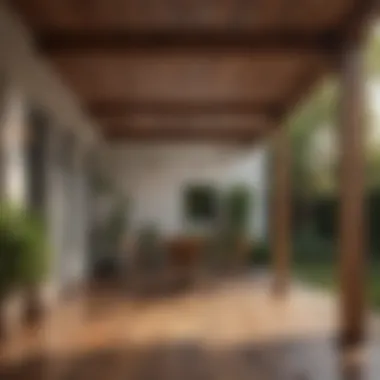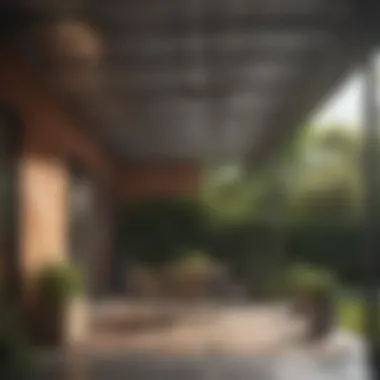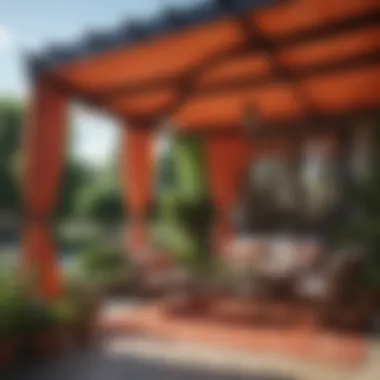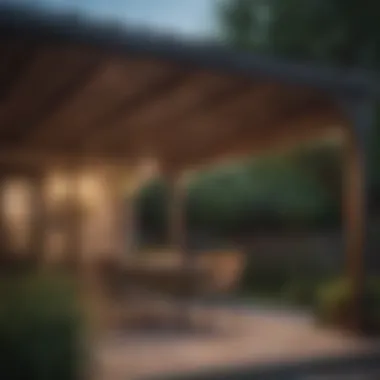Affordable Patio Covers: Enhance Your Outdoor Space


Intro
In recent years, the outdoor living space has evolved into an extension of the home. Homeowners and renters alike now seek to enhance these areas for relaxation and social gatherings. While luxurious patio covers often capture attention, many are not financially feasible for everyone. This is where inexpensive patio covers come into play. They offer functional benefits without breaking the bank.
Understanding the options available can empower you to make informed choices. This article will discuss various types of materials, styles, and installation options suitable for anyone looking to improve their outdoor environment. We will also delve into maintenance tips and seasonal adaptations that maximize usability throughout the year.
Patio covers not only protect from the sun but also serve a decorative purpose. They create a cozy atmosphere and provide comfort during any gathering. The guidance provided here aims to help you balance aesthetics with functionality, all while keeping costs manageable.
Existence of limitations on budget does not prevent individuals from finding aesthetically pleasing solutions. In fact, diverse inexpensive options hint at creativity, leading to personalized outdoor experiences. Let us begin by exploring design inspiration, which can influence both style and functionality.
Prologue to Patio Covers
Patio covers serve as a practical solution for those seeking to enhance their outdoor spaces while mitigating environmental exposure. Understanding the types and benefits of patio covers can be vital for homeowners and renters alike. This section will detail the nature of patio covers, emphasizing their role in improving outdoor usability and comfort.
Defining Patio Covers
Patio covers, often referred to as awnings or canopies, are structures designed to shield outdoor areas from various weather conditions. They come in different forms, including fabric, aluminum, and wood. These structures can be freestanding or attached to an existing building, offering flexibility in design and functionality. The primary function of patio covers is to provide shade in sunny weather, which can significantly improve the comfort of outdoor activities.
Importance of Protection from the Elements
Protection from environmental elements is a fundamental reason for investing in patio covers. By shielding outdoor spaces, these structures can prevent excessive sun exposure, protecting furniture and decor from fading. Additionally, patio covers can serve as barriers against rain and wind, allowing for outdoor enjoyment regardless of weather conditions.
Moreover, they enable homeowners to create versatile spaces such as dining areas, lounges, or outdoor kitchens, thus enhancing the practical use of home exteriors. Understanding the necessity of these covers is crucial for making informed decisions about outdoor improvements.
"Investing in a good patio cover not only beautifies the space but enhances its practicality, making it usable across different seasons."
The relevance of patio covers stretches beyond mere aesthetics. They provide a sanctuary, extending the living area and integrating nature into everyday life. In a world where outdoor living spaces have become cherished areas for recreation and socializing, patio covers emerge as essential components.
Types of Patio Covers
The selection of patio covers plays a crucial role in enhancing outdoor spaces. Types of patio covers offer various benefits tailored to different needs and preferences. Understanding these types ensures homeowners and renters make informed decisions regarding aesthetics, functionality, and budget. Each type brings specific characteristics that address environmental challenges, personal style, and usability. This section will detail the various options available, allowing readers to choose the most suitable patio cover for their circumstances.
Fabric Covers
Fabric covers are lightweight and can provide flexible options for shade and shelter. They come in many styles, such as retractable awnings and canopy covers, allowing for versatile usage based on seasonal needs. One significant advantage of fabric covers is their affordability. They come at a lower cost compared to more permanent structures. Maintanance requirements are relatively straightforward; regular cleaning helps prolong their lifespan. It’s essential to select a UV-resistant fabric to resist fading and tearing, especially in harsh climates. Here are a few benefits of fabric covers:
- Affordability: Generally lower initial investment.
- Variety: Available in various colors and designs.
- Ease of Installation: Many designs are suitable for DIY installation.
Aluminum Covers
Aluminum covers have gained popularity due to their durable nature and low maintenance requirements. Unlike fabric, they do not fade or tear easily. They are particularly effective for providing shelter from rain and UV rays. These covers can come in several styles, including louvered roofs and solid panels, offering an elegant touch to outdoor environments. While the upfront cost may be higher than fabric options, their longevity often makes them a smart investment for those seeking a long-term solution. Important considerations include:
- Durability: Withstands various weather conditions.
- Low Maintenance: Requires minimal upkeep over time.
- Versatile Designs: Options that can match a variety of architectural styles.
Wooden Structures
Wooden structures often evoke a timeless aesthetic that many homeowners find appealing. They provide a sturdy framework for creating a natural outdoor ambiance. However, it’s crucial to acknowledge the additional costs related to maintaining wood against decay and pests. Using treated lumber can mitigate these issues. It is vital to apply protective finishes regularly. Wooden patio covers can accommodate various designs from pergolas to full gazebos, adding significant value and charm to outdoor space. Some of the benefits include:
- Natural Appearance: Complements gardens and green spaces.
- Customization: High potential for tailored designs to fit specific needs.
- Structural Integrity: Provides a strong and stable shelter.
Vinyl Options


Vinyl options present another practical alternative for patio covers. They offer a unique blend of durability and low maintenance similar to aluminum. Vinyl is resistant to fading, cracking, and peeling, making it a reliable choice. One of the appeals of vinyl is its lightweight nature, making installation effortless in most cases. These covers are not highly customizable, but with various pre-selected styles available, they still manage to integrate well into many home environments. Some noteworthy aspects include:
- Affordability: Generally, cost-effective compared to wood and metal.
- Maintenance-Free: Natural resistance to weathering.
- Color Options: Available in various colors to match your personal style.
Cost-Effective Materials
When considering the construction or renovation of patio covers, the choice of materials plays a crucial role. Cost-effective materials are not only about lower initial expenses; they involve a comprehensive assessment of longevity, maintenance, and functionality. Selecting the right materials can significantly impact both the financial investment and the overall aesthetic appeal of your outdoor space.
Evaluating Material Lifespan
Understanding the lifespan of materials is essential when deciding on patio covers. Some materials may have a lower upfront cost but will need replacement or repair sooner than others. For example, fabric covers might be less expensive initially but often have a shorter lifespan due to their susceptibility to weathering. On the other hand, materials such as aluminum or vinyl may present a higher initial investment but offer greater durability in the long run.
- Aluminum: Resistant to corrosion and rust, often lasting several decades.
- Vinyl: Requires little maintenance and can last up to 20 years.
- Wood: Offers aesthetic appeal but needs regular treatment to prevent decay, potentially reducing its lifespan.
Each homeowner should assess how frequently they wish to replace or repair their patio cover and factor this into their material choice.
Environmental Considerations
Selecting materials for patio covers also opens discussions about environmental impact. Sustainable materials can significantly minimize one’s ecological footprint. Using reclaimed wood, for example, not only reduces waste but adds character to the outdoor space. Similarly, opting for eco-friendly finishes on wood or non-toxic coatings on metals can enhance the sustainability of the covers.
When choosing materials, here are some considerations that also benefit the environment:
- Recyclability: Aluminum and vinyl are both recyclable, which lowers their overall impact on landfills.
- Local Sourcing: Choosing locally sourced materials can reduce transportation emissions, making a more environmentally responsible choice.
"Sustainability in home improvement does not only preserve nature; it reflects values that can enhance home value over time."
A thoughtful approach to material selection, considering both the lifespan and environmental ramifications, allows homeowners to create beautiful and functional outdoor spaces while being responsible stewards of their surroundings.
Design Considerations
Design considerations play a crucial role in the effectiveness and appeal of inexpensive patio covers. When selecting a patio cover, it is essential to assess how it can complement the existing structure of your home while also meeting your functional needs. An appropriately designed patio cover not only enhances your outdoor space but also contributes to the overall aesthetic of your property. There are several key elements to review, such as layout, materials, and how well the cover integrates with your home’s architecture.
Functional Layouts
A functional layout is one that maximizes utility in the outdoor space while considering traffic flow and activity requirements. Ideally, the patio cover should align with how you plan to use the area beneath it. If you envision hosting gatherings, ensure enough space for seating and movement. Conversely, if the goal is to create a quiet retreat, a more intimate setting with a smaller cover may suffice.
Some considerations for functional layouts include:
- Purpose: Identify whether the area will be used for dining, relaxation, or recreation.
- Orientation: Position the cover based on sun exposure and wind direction to optimize comfort year-round.
- Access: Ensure easy access points from the house and from any garden areas.
By focusing on these aspects, a well-planned layout will enhance the usability and enjoyment of the patio, making it a more inviting place for personal leisure or social activities.
Aesthetic Integration with Home
Aesthetics significantly influence how a patio cover will be perceived once installed. It should seamlessly integrate with the home’s architectural style while also enhancing the overall landscaping. A cohesive look invites a sense of harmony in the exterior design.
There are a few strategies to ensure aesthetic integration:
- Color Matching: Choose colors that complement your home’s exterior. Neutral tones often work wonders by blending without overwhelming the scene.
- Material Consistency: If your home features natural wood, consider wooden or vinyl covers that mimic that texture. For a modern home, aluminum may provide the sleek look desired.
- Architectural Details: Incorporate elements such as beams, rafters, or decorative details that reflect the style of the house.
The design of a patio cover can be as significant as the selection of its materials. Proper design fosters a coherent transition between indoor and outdoor living, enhancing the value of the entire property.
By focusing on functional layouts and aesthetic integration, homeowners can create patio covers that not only fulfill practical needs but also enhance the beauty and value of their homes.


Installation Processes
The installation process of patio covers is a crucial aspect that influences both the quality of the end product and the overall satisfaction of the homeowner. Understanding this process provides valuable insight into the options available, the costs one can expect, and the potential pitfalls to avoid. Choosing the right installation method can have lasting effects on the durability and usability of patio covers. Moreover, it also impacts aesthetic appeal, making it a significant topic within the discussion of inexpensive patio covers.
In this section, we must consider two main areas: DIY versus professional installation and the necessary permits and regulations that could affect the installation of patio covers. Each option presents distinct advantages and challenges that homeowners should weigh carefully.
DIY vs. Professional Installation
Choosing between DIY installation and hiring a professional depends on various factors. The DIY option attracts many homeowners due to cost savings and the satisfaction of completing a project independently. However, this approach requires a certain level of skill and tools.
Benefits of DIY Installation:
- Cost Savings: Doing it yourself can eliminate labor costs.
- Personal Satisfaction: Completing a project on your own can be rewarding.
- Customization: You can make changes as you go without consulting a professional.
Considerations for DIY:
- Skill Level: Assess your ability. Some installations require advanced skills.
- Time Investment: DIY may take longer than expected, especially for first-timers.
- Potential Mistakes: Errors in installation can lead to additional costs later on.
On the other hand, professional installation ensures that the job is done correctly the first time. Benefits of hiring professionals include:
- Expertise: Professionals have the experience to handle unexpected issues.
- Efficiency: They usually complete the job faster than a novice would.
- Warranty Assurance: Many companies provide warranties on their workmanship.
Permits and Regulations
Before beginning any installation work, it is important to familiarize yourself with local permits and regulations that could apply to your patio cover project. Neglecting this aspect can lead to fines or the requirement to dismantle improperly installed structures.
Common Considerations Include:
- Building Codes: Local building codes set standards for installations, ensuring safety and structural integrity.
- Zoning Laws: These laws often restrict certain types of structures based on property lines and neighborhood aesthetics.
- Homeowners Association Rules: Some neighborhoods have specific guidelines regarding exterior renovations, including patio covers.
Reading the local laws can spare a lot of future trouble. It is advisable to consult official city or county websites for guidance.
Proper planning and adherence to regulations not only ensure safety but also enhance the value of your property.
To conclude this section, whether deciding on DIY installation or hiring professionals, and understanding the legal landscape, both paths require careful thought. Each choice impacts the overall success and enjoyment of your outdoor space.
Maintenance of Patio Covers
Maintaining patio covers is essential for ensuring their longevity and continued aesthetic appeal. Proper upkeep protects your investment and enhances the outdoor experience. Factors like weather and usage can significantly impact the condition of your patio cover. Thus, regular maintenance can prevent costly repairs or replacements.
Maintaining patio covers involves different aspects, such as cleaning and seasonal preparations. Regular maintenance also ensures that your outdoor space remains inviting and functional. Homeowners can enjoy a well-preserved area for gatherings, relaxation, and creative activities. It’s a matter of preventive care, and understanding your material’s specifics is vital for effective maintenance practice.
Regular Cleaning Practices
Cleaning your patio cover regularly is key to its maintenance. Dirt, leaves, and debris can accumulate and affect its appearance and performance. The cleaning method varies depending on the material of the cover. For instance, fabric covers require gentle pressure washing or a soft brush to avoid damage. On the other hand, aluminum and vinyl covers can often be cleaned with soap and water using a non-abrasive sponge.
Here are some general guidelines for cleaning:
- Inspect the Cover: Look for tears, rust, or discoloration to address these issues early.
- Use Appropriate Cleaners: Avoid harsh chemicals that can degrade the fabric or surface. Instead, use mild soap and water.
- Establish a Schedule: Regularly clean according to the season. This helps in managing debris and stains effectively.
Regular cleaning ensures that your patio looks fresh and minimizes potential long-term damage. A clean cover also keeps your outdoor area more appealing for gatherings and family get-togethers.


Seasonal Preparations
Preparing your patio cover for different seasons is critical to prolong its life. Different weather conditions can present various challenges, from snow in winter to dust storms in spring.
Here are some seasonal preparation tips:
- Spring: Inspect for winter damage and clear away any clutter. Check the fabric and structural integrity thoroughly.
- Summer: Ensure sufficient ventilation for fabric covers to avoid mildew growth. Regularly clear away leaves and pollen.
- Autumn: Before the leaves fall, consider covering the patio to protect against debris accumulation. This is also a good time to check for any potential issues before winter.
- Winter: If applicable, remove excess snow and ice to prevent sagging or damage. Ensure that any heating or insulation options are functional.
By investing time in seasonal preparations, homeowners can ensure that their patio covers endure changing climates and remain a vital part of their exterior space. These practices foster a pleasing environment and safeguard investment in home enhancements.
Maximizing Usability
The notion of maximizing usability in patio coverings transcends mere aesthetic appeal. It hinges on how effectively these outdoor structures can enhance a homeowner's lifestyle. An inexpensive patio cover must serve as a functional extension of the living space. Essential elements include adaptability to various activities, creating a comfortable environment, and ensuring year-round usability. When well planned, these covers enable homeowners to utilize outdoor spaces for diverse purposes without facing the limitations of weather.
Creating Outdoor Living Spaces
To foster a harmonious blend of indoor and outdoor life, creating structured outdoor living spaces is pivotal. This process involves thoughtful planning to shape areas that are both welcoming and functional. Incorporating furniture like lounges, dining sets, or even reading nooks can transform a simple patio into a multifunctional space. Considermarking off spaces with rugs or deck tiles for definition.
Moreover, the design should allow for easy flow between the home and the outdoor area. Elements such as fire pits can also enhance the usability, promoting social interaction and extending evening activities. Homeowners should be deliberate about the spacing and orientation of furniture to optimize comfort and usability in these areas.
Incorporating Lighting and Heating
Another critical aspect of maximizing usability lies in the integration of lighting and heating solutions. Well-placed lighting can create a cozy atmosphere and enhance safety during evening hours. Options range from string lights to spotlights, each providing unique benefits.
Heating features like patio heaters or fire pits allow for continuous use of the space, even in cooler months. This combination not only extends the utility of your patio cover, but it can also enhance its overall appeal. When selected thoughtfully, these features add comfort and elegance without overwhelming the design.
Inexpensive DIY Ideas
Creating a patio cover on a budget does not have to be a daunting task. The importance of inexpensive DIY ideas lies in their ability to enhance outdoor spaces without straining finances. Many homeowners wish to expand their usable area outdoors. DIY projects can provide personal satisfaction, an opportunity to learn new skills, and, of course, substantial savings. Additionally, this approach allows for creativity in design and personalization that pre-fabricated options lack.
Repurposed Materials
Using repurposed materials for patio covers is both eco-friendly and economical. It allows one to recycle items that would otherwise contribute to waste. Here are several common materials:
- Old pallets: They can be arranged to form a rustic cover.
- Barn doors: These can bring a charming farmhouse feel while providing sufficient coverage.
- Wooden crates: Stacked or placed on beams, they can add visual interest and shade.
Repurposing materials often requires minimal investment, usually just the cost of transportation and some basic tools. Advantages include the uniqueness of the design and a lower environmental impact. However, it's essential to assess the condition of materials to ensure durability and safety over time.
Budget-Friendly Designs
Implementing budget-friendly designs is crucial for those who want a visually appealing patio cover without high expenditures. Here are several design strategies:
- Canopy Tents: These are portable and can be set up quickly for gatherings. They are easily adjustable and affordable.
- Retractable Awnings: Offering flexibility to control shade, retractable awnings are also easier to install than permanent structures.
- Sail Shades: Made from durable fabric, these offer sun protection and are easy to install with minimal aspects.
Considerations when choosing designs include local weather conditions and potential zoning regulations. A well-planned design takes into account not just aesthetic but also functional aspects. Overall, these designs can significantly elevate outdoor usability, creating comfortable spaces for relaxation and entertainment without financial burden.
Closure
The conclusion of this article serves as an essential reflection on the various aspects of patio covers, particularly focusing on the inexpensive options available. A well-implemented patio cover serves multiple functions. It enhances outdoor spaces, offering protection from harsh weather elements, while also adding value to a property. On a practical note, patio covers extend the usability of outdoor areas for various activities such as gatherings, dining, or simply relaxing with a book.
Final Thoughts on Patio Covers
In summary, patio covers are not just about aesthetics, they play a vital role in maximizing outdoor living potential. Homeowners should focus on affordable options that do not compromise quality. Budget-friendly materials like fabric, vinyl, or even repurposed wood can provide effective solutions without extensive costs. Making informed choices regarding the style, materials, and design will lead to satisfying outdoor experiences.
Future Trends in Patio Cover Design
As we look ahead, several trends are emerging in patio cover design. Homeowners are increasingly interested in sustainability, prompting the use of eco-friendly materials and designs that harmonize with nature. Technology is also playing a role. Integrated lighting, solar panels, and automated systems for adjustable covers are becoming more common. These elements not only emphasize personal style but also enhance functionality.
In essence, the future of patio covers leans towards innovative, stylish, and environmentally conscious solutions. As styles evolve, so too will the strategies for creating inviting outdoor environments.



